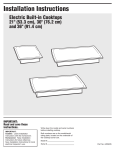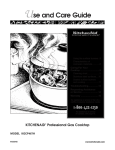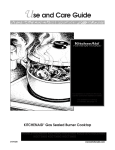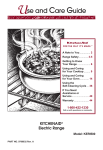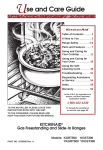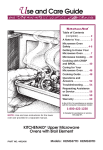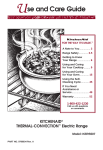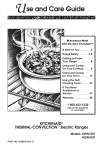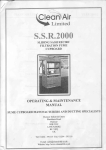Download KitchenAid KECS100 User's Manual
Transcript
3191536v07c26 8/27/98 9:27 AM Page 1 Use and Care Guide ® ® Table of Contents..........2 A Note to You.................2 Cooktop Safety .............3 Getting to Know Your Cooktop.................5 Using Your Cooktop..........................6 Caring for Your Cooktop..........................9 Troubleshooting ..........14 Requesting Assistance or Service.....................15 Warranty.......................16 1-800-422-1230 Call our Consumer Assistance Center with questions or comments. KITCHENAID® Electric Built-In Cooktop Models: KECS100 KECS161 3191536 www.kitchenaid.com 3191536v07c26 8/27/98 9:27 AM Page 2 Table of Contents A Note to You .............................................2 Caring for Your Cooktop ...........................9 Cooktop Safety ..........................................3 Coil elements and reflector bowls .........9 Getting to Know Your Cooktop ................5 Control knob collars.............................10 Using Your Cooktop ..................................6 Cleaning chart......................................11 Using the surface cooking area ............6 Stainless steel surfaces.......................12 Characteristics of cookware materials ...8 Cleaning the area under the cooktop ..13 Cookware tips .......................................8 Troubleshooting .......................................14 Requesting Assistance or Service .........15 Warranty....................................................16 A Note to You Thank you for buying a KITCHENAID ® appliance! KitchenAid designs the best tools for the most important room in your house. To ensure that you enjoy many years of trouble-free operation, we developed this Use and Care Guide. It contains valuable information concerning how to operate and maintain your new appliance properly and safely. Please read it carefully. Also, please complete and mail the enclosed Product Registration Card. Please record your model’s information. Whenever you call our Consumer Assistance Center at 1-800-422-1230 or request service for your appliance, you need to know your complete model number and serial number. You can find this information on the model and serial number plate (see illustration on page 5 for location of plate). Please also record the purchase information. Model Number __________________________ Serial Number __________________________ Purchase/ Installation Date ________________________ Builder/Dealer Name __________________________________ Address ________________________________ Phone__________________________________ NOTE: You must provide proof of purchase or installation date for in-warranty service. Keep this book and the sales slip together in a safe place for future reference. 2 3191536v07c26 8/27/98 9:27 AM Page 3 Cooktop Safety Your safety and the safety of others is very important. We have provided many important safety messages in this manual and on your appliance. Always read and obey all safety messages. This is the safety alert symbol. This symbol alerts you to hazards that can kill or hurt you and others. All safety messages will be preceded by the safety alert symbol and the word “DANGER” or “WARNING.” These words mean: wDANGER You will be killed or seriously injured if you don’t follow instructions. wWARNING You can be killed or seriously injured if you don’t follow instructions. All safety messages will identify the hazard, tell you how to reduce the chance of injury, and tell you what can happen if the instructions are not followed. IMPORTANT SAFETY INSTRUCTIONS WARNING – To reduce the risk of fire, electrical shock, injury to persons, or damage when using the cooktop, follow basic precautions, including the following: • • • • • CAUTION – Do not store items of interest to children in cabinets above a cooktop – Children climbing on the cooktop to reach items could be seriously injured. Proper Installation – Be sure your cooktop is properly installed and grounded by a qualified technician. Never Use Your Cooktop for Warming or Heating the Room. Do Not Leave Children Alone – Children should not be left alone or unattended in area where cooktop is in use. They should never be allowed to sit or stand on any part of the cooktop. Wear Proper Apparel – Loose-fitting or hanging garments should never be worn while using the cooktop. • User Servicing – Do not repair or replace any part of the cooktop unless specifically recommended in the manual. All other servicing should be referred to a qualified technician. • Storage on Cooktop – Flammable materials should not be stored near surface units. • Do Not Use Water on Grease Fires – Smother fire or flame or use dry chemical or foam-type extinguisher. • Use Only Dry Potholders – Moist or damp potholders on hot surfaces may result in burns from steam. Do not let potholder touch hot heating elements. Do not use a towel or other bulky cloth. – SAVE THESE INSTRUCTIONS – continued on next page 3 3191536v07c26 8/27/98 9:27 AM Page 4 C ooktop Safety IMPORTANT SAFETY INSTRUCTIONS • DO NOT TOUCH SURFACE UNITS OR AREAS NEAR UNITS – Surface units may be hot even though they are dark in color. Areas near surface units may become hot enough to cause burns. During and after use, do not touch, or let clothing or other flammable materials contact surface units or areas near units until they have had sufficient time to cool. Among those areas are the cooktop and surfaces facing the cooktop. • Use Proper Pan Size – This cooktop is equipped with one or more surface units of different size. Select utensils having flat bottoms large enough to cover the surface unit heating element. The use of undersized utensils will expose a portion of the heating element to direct contact and may result in ignition of clothing. Proper relationship of utensil to burner will also improve efficiency. • Never Leave Surface Units Unattended at High Heat Settings – Boilover causes smoking and greasy spillovers that may ignite. • Glazed Cooking Utensils – Only certain types of glass, glass/ceramic, ceramic, earthenware, or other glazed utensils are suitable for cooktop service without breaking due to the sudden change in temperature. • Utensil Handles Should Be Turned Inward and Not Extend Over Adjacent Surface Units – To reduce the risk of burns, ignition of flammable materials, and spillage due to unintentional contact with the utensil, the handle of a utensil should be positioned so that it is turned inward, and does not extend over adjacent surface units. • Do Not Cook on Broken Cooktop – If cooktop should break, cleaning solutions and spillovers may penetrate the broken cooktop and create a risk of electric shock. Contact a qualified technician immediately. • Clean Cooktop With Caution – If a wet sponge or cloth is used to wipe spills on a hot cooking area, be careful to avoid steam burn. Some cleaners can produce noxious fumes if applied to a hot surface. For units with ventilating hood – • Clean Ventilating Hoods Frequently – Grease should not be allowed to accumulate on hood or filter. • When flaming foods under the hood, turn the fan off. The fan, if operating, may spread the flame. – SAVE THESE INSTRUCTIONS – 4 3191536v07c26 8/27/98 9:27 AM Page 5 Getting to Know Your Cooktop Model KECS161 (36 inches) (Model KECS100 not shown) Model and serial number plate (inside burner box) Plug-in coil element with one-piece reflector bowl Control panel POWER™Burner coil element Control panel Control knob collar Center rear control knob ED M ED M HI L HI L HI ED M LO LO LO OFF L HI I ED M M LO LO ED MED MED MED MED Left front control knob H O HI H I L I Right rear control knob MED MED OFF O H O MED MED MED MED H O I Left rear control knob OFF OFF H I L OFF O Power on indicator light Right front control knob 5 3191536v07c26 8/27/98 9:27 AM Page 6 Using Your Cooktop wWARNING Fire Hazard Turn off all controls when done cooking. Failure to do so can result in death or fire. Using the surface cooking area Push in control knobs before turning them to a setting. Set them anywhere between HI and OFF. H ED MED HI I L OFF O M LO MED HI L ED HI ED M LO 6 MED LO MED H O I I L H MED The Power on indicator light will glow when any of the coil element(s) are turned on. OFF OFF O M Power on indicator light MED 3191536v07c26 8/27/98 9:27 AM Page 7 U sing your Cooktop Until you get used to the settings, use the following as a guide. For best results, start cooking at the high setting; then turn the control knob down to continue cooking. SETTING RECOMMENDED USE HI • To start food cooking. • To bring liquid to a boil. MED-HI or 6-8 • To hold a rapid boil. • To quickly brown or sear meat. MED or 5 • To maintain a slow boil. • To fry poultry or meat. • To make pudding, sauce, or gravy. MED-LO or 2-4 • To stew or steam food. • To simmer food. LO • To keep food warm. Set the heat higher or lower within the LO (or 1) band to keep food at the temperature you want. • To maintain liquid just below simmer. • To melt chocolate or butter. Home canning information Center over coil element Pan Coil element • Use flat-bottomed canners on all types of cooktops, especially ceramic glass. Canners with rippled or ridged bottoms do not allow good contact with the surface. • Center the canner over the largest coil element. Do not extend more than one inch outside the coil element. Large diameter canners/pans, if not centered correctly, trap heat and can cause damage to the cooktop. • Do not place your canner on two coil elements at the same time. • The type of material the canner is made of determines the length of heating time. Refer to the “Characteristics of cookware materials” chart later in this section for more information. • When canning for long periods of time, allow elements and the surrounding surfaces to cool down. • Alternate use of the coil elements between batches or prepare small batches at a time. • Start with hot water, cover with a lid, and bring to a boil; then reduce heat to maintain a boil or required pressure levels in a pressure canner. • Keep reflector bowls clean so that they will always reflect heat well. • For up-to-date information on canning, contact your local U.S. Government Agricultural Department Extension Office or companies who manufacture home canning products. Optional canning kit Most water-bath or pressure canners have large diameters. If you do canning with them at high heat settings for long periods of time, you can shorten the life of regular coil elements. This can also damage the cooktop. If you plan to use the cooktop for canning, we recommend the installation of a Canning Kit. Order the kit (Part No. 242905) from your dealer or authorized service company. 7 3191536v07c26 8/27/98 9:27 AM Page 8 U sing your Cooktop Characteristics of cookware materials The pan material affects how fast heat transfers from the coil element through the pan material and how evenly heat spreads over the pan bottom. Choose pans that provide the best cooking results. Aluminum • Heats quickly and evenly. • Use for all types of cooking. • Medium or heavy thickness is best for most cooking. • Used as a core or base in cookware to provide even heating. Cast iron • Heats slowly and evenly. • Good for browning and frying. • Maintains heat for slow cooking. • Can be coated with porcelain enamel. Ceramic or ceramic glass • Heats slowly and unevenly. • Use on low to medium settings. • Follow manufacturer’s instructions. Copper • Heats very quickly and evenly. • Used as a core or base in cookware to provide even heating. Earthenware • Can be used for cooktop cooking if recommended by the manufacturer. • Use on low settings. Porcelain enamel-on-steel • See cast iron and stainless steel. or enamel-on-cast iron Stainless steel • Heats quickly but unevenly. • A core or base of aluminum or copper on the cookware provides even heating. • Can be coated with porcelain enamel. Cookware tips • Select a pan that is about the same size as the coil element. Cookware should not extend more than 1 inch outside the area. • For best results and greater energy efficiency, use only flat-bottomed cookware that makes good contact with the coil element. Cookware with rounded, warped, ribbed (such as some porcelain enamelware), or dented bottoms could cause uneven heating and poor cooking results. • Cookware with non-stick finish has heating characteristics of the base material. 8 • Use flat bottom cookware for best heat conduction from the coil element to the cookware. Determine flatness with the ruler test. Place the edge of a ruler across the bottom of the cookware. Hold it up to the light. No light should be visible under the ruler. Rotate the ruler in all directions and look for any light. • Do not leave empty cookware, or cookware that has boiled dry, on a hot coil element. The cookware could overheat, causing damage to the cookware or the coil element. 3191536v07c26 8/27/98 9:27 AM Page 9 Caring for Your Cooktop WARNING Explosion Hazard Do not store flammable materials such as gasoline near this appliance. Doing so can result in death, explosion, or fire. Coil elements and reflector bowls Removing 1. Make sure all coil elements are off and cool before removing coil elements and reflector bowls. 4. Lift out the reflector bowl. See the “Cleaning chart” later in this section for cleaning instructions. H ED MED HI I L OFF O M LO MED 2. Push in the edge of the coil element, opposite the receptacle. Then lift it just enough to clear the reflector bowl. Replacing 1. Make sure all coil elements are off and cool before replacing coil elements and reflector bowls. OFF HI L ED MED LO M from the receptacle. H O I 3. Pull the coil element straight away MED 9 3191536v07c26 8/27/98 9:27 AM Page 10 C aring for your Cooktop Coil elements and reflector bowls (cont.) 2. Line openings in the reflector bowl up with the coil element receptacle. 3. Hold the coil element as level as possible with the terminal just started into the receptacle. Push the coil element terminal into the receptacle. 4. When the terminal is pushed into the receptacle as far as it will go, push down the edge of the coil element opposite the receptacle. NOTE: Reflector bowls reflect heat back to the cookware on the coil elements. They also help catch spills. When they are kept clean, they reflect heat better and look new longer. If a reflector bowl changes color, some of your cookware may not be flat enough, or some may be too large for the coil element. In either case, some of the heat that is meant to go into or around cookware goes down and heats the reflector bowl. This extra heat can cause it to change color. Control knob collars Removing 1. Turn knobs off and pull upward to remove. Place index finger inside center of collar and pull firmly upward to release. 10 Replacing 2. To replace, align pins on underside of collar with holes on cooktop surface and press down firmly. 3191536v07c26 8/27/98 9:27 AM Page 11 C aring for your Cooktop Cleaning chart Before cleaning, always make sure all controls are off and the cooktop is cool. Refer to instuctions on all cleaning products before using them to clean your cooktop. PART CLEANING METHOD SPECIAL INSTRUCTIONS Control Knobs and Collars • Soap and water • Dishwasher • DO NOT use steel wool or abrasive cleaners. • Pull knobs straight away from control panel. • Wash, rinse and dry with soft cloth. Exterior Surfaces* (excluding control panel) • Soap and water • Mild liquid cleaner • Spray glass cleaner • DO NOT use abrasive or • Non-abrasive plastic • Gently clean around the scrubbing pad harsh cleaners like chlorine bleach, ammonia or oven cleaners. • Wash, rinse and dry with soft cloth. model and serial plate; too much scrubbing could remove the numbers. • DO NOT clean or immerse Coil Elements in water. Spatters and spills will burn off. Chrome reflector bowls* • Light to moderate soil • Soap and water • Non-abrasive plastic • Wash, rinse and dry with soft cloth. scrubbing pad • Heavy to burned-on soils • Dishwasher • Solution of 1/2 cup ammonia to 1 gallon water • Non-abrasive plastic scrubbing pad • Mild abrasive powdered cleanser or commercial oven cleaner • Soak bowls for 20 minutes, then scrub with plastic pad. *When the cooktop is cool, remove all spills and clean. Food spills containing acids, such as vinegar and tomato, may affect the finish. 11 3191536v07c26 8/27/98 9:27 AM Page 12 C aring for your Cooktop Stainless steel surfaces Cleaning Stainless Steel Surfaces • • • • Do not use steel wool or soap-filled scouring pads. Rub in the direction of the grain line to avoid marring the surface. Always wipe dry to avoid water marks. If commercial cleaners are used, follow label directions. If product contains chlorine (bleach), rinse thoroughly and dry with a soft, lint-free cloth. Chlorine is a corrosive substance. CLEANING AGENT HOW TO USE Routine cleaning and fingerprints Liquid detergent and water, all-purpose cleaner Wipe with damp cloth or sponge, then rinse with clean water and wipe dry. Stubborn stains and baked-on residue Mild abrasive cleanser or stainless steel cleaners Rub in the direction of the grain lines with a damp cloth or sponge and cleaner. Rinse thoroughly. Repeat if necessary. Hard water spots Vinegar Swab or wipe with cloth. Rinse with water and dry. 12 3191536v07c26 8/27/98 9:27 AM Page 13 C aring for your Cooktop Cleaning the area under the cooktop 1. Remove all elements and reflector bowls. 2. Place hands under left and right rear element opening areas and lift (approx. 3⁄8”). When you hear a click, the Posi-lock button is correctly engaged. 3. To open, grip the left and right front 5. After cleaning, lift cooktop slightly to disengage support rod, then lower front to countertop level. Reach into left and right rear element opening areas and press Posi-lock button to disengage. This will return back of cooktop to countertop level. Posi-lock button element openings and lift. The support rod will swing forward. Pull the rod until it rests at the front edge of the burner box. 4. Wipe surface under the cooktop with warm, soapy water. Use a nonabrasive, soap-filled plastic scrubbing pad on heavily soiled areas. 13 3191536v07c26 8/27/98 9:27 AM Page 14 Troubleshooting You can solve many common cooktop problems easily, saving you the cost of a possible service call. Try the suggestions below to see if you can solve your problem without outside help. If the suggestions do not work, see “Requesting Assistance or Service” on page 15. PROBLEM Nothing will operate POSSIBLE CAUSE The unit is not wired into a live circuit with proper voltage. A household fuse has blown or a circuit breaker has tripped. SOLUTION Wire the unit into a live circuit with proper voltage. (See Installation Instructions.) Replace household fuse or reset circuit breaker. The coil element(s) will not operate A household fuse has blown or a circuit breaker has tripped. Replace household fuse or reset circuit breaker. You have not plugged in coil elements all the way. You are not setting the control knobs correctly. Turn control knobs to OFF and plug coil elements in all the way. (See “Replacing” on page 9.) Push control knobs in before turning to a setting. Control knob(s) will not turn You are not pushing in before turning. Push control knob(s) in before turning to a setting. Cooking results are not what you expected The cooktop is not level. Level cooktop. (See Installation Instructions. Also, see "Cleaning the area under the cooktop," page 13, number 5). The pan used is not the correct type or size. Refer to a reliable cookbook for recommended pan type and size. Cookware does not fit the coil element being used. Pan should be the same size or slightly larger than the coil element being used. 14 3191536v07c26 8/27/98 9:27 AM Page 15 Requesting Assistance or Service Before calling for assistance or service, please check the “Troubleshooting Guide” section. It may save you the cost of a service call. If you still need help, follow these instructions. If you need assistance or service Call the KitchenAid Consumer Assistance Center toll free: 1-800-422-1230. Our consultants are available to assist you. When calling: Please know the purchase date and the complete model and serial number of your appliance (see the “A Note to You” section). This information will help us to better respond to your request. Our consultants provide assistance with: • Features and specifications on our full line of appliances. • Installation information. • Use and maintenance procedures. • Accessory and repair parts sales. • Specialized customer assistance (Spanish speaking, hearing impaired, limited vision, etc.). • Referrals to local dealers, service companies, and repair parts distributors. KitchenAid service technicians are trained to fulfill the product warranty and provide after-warranty service, anywhere in the United States. To locate the authorized KitchenAid service company in your area, you can also look in your telephone directory Yellow Pages. If you need replacement parts If you need to order replacement parts, we recommend that you only use factory authorized parts. These parts will fit right and work right, because they are made with the same precision used to build every new KITCHENAID® appliance. To locate factory authorized replacement parts in your area, call our Consumer Assistance Center telephone number or your nearest authorized service center. For further assistance If you need further assistance, you can write to KitchenAid with any questions or concerns at: KitchenAid Brand Home Appliances Consumer Assistance Center c/o Correspondence Dept. 2000 North M-63 Benton Harbor, MI 49022-2692 Please include a daytime phone number in your correspondence. 15 3191536v07c26 8/27/98 9:27 AM Page 16 Electric Cooktop Warranty LENGTH OF WARRANTY: KITCHENAID WILL PAY FOR: KITCHENAID WILL NOT PAY FOR: ONE-YEAR FULL WARRANTY FROM DATE OF PURCHASE Replacement parts and repair labor costs to correct defects in materials or workmanship. Service must be provided by an authorized KitchenAid servicing outlet. A. Service calls to: 1. Correct the installation of the cooktop. 2. Instruct you how to use the cooktop. 3. Replace house fuses or correct house wiring. 4. Correct house plumbing. SECONDTHROUGH FIFTH-YEAR LIMITED WARRANTY FROM DATE OF PURCHASE Replacement parts for any electric element to correct defects in materials or workmanship. B. Repairs when cooktop is used in other than normal home use. C. Damage resulting from accident, alteration, misuse, abuse, fire, flood, acts of God, improper installation, or installation not in accordance with local electrical or plumbing codes. D. Any labor costs during the limited warranties. E. Replacement parts or repair labor costs for units operated outside the United States. F. Pickup and delivery. This product is designed to be repaired in the home. G. Repairs to parts or systems resulting from unauthorized modifications made to the appliance. 8/98 KITCHENAID DOES NOT ASSUME ANY RESPONSIBILITY FOR INCIDENTAL OR CONSEQUENTIAL DAMAGES. Some states do not allow the exclusion or limitation of incidental or consequential damages, so this exclusion or limitation may not apply to you. This warranty gives specific legal rights and you may also have other rights which vary from state to state. Outside the United States, a different warranty may apply. For details, please contact your authorized KitchenAid dealer. If you need assistance or service, first see the “Troubleshooting” section of this book. After checking “Troubleshooting,” additional help can be found by checking the “Requesting Assistance or Service” section. In the U.S.A., call our Consumer Assistance Center at 1-800-422-1230. 3191536 © 1998 KitchenAid ® Trademark/TM Trademark of KitchenAid, U.S.A. 9/98 Printed in U.S.A.


















